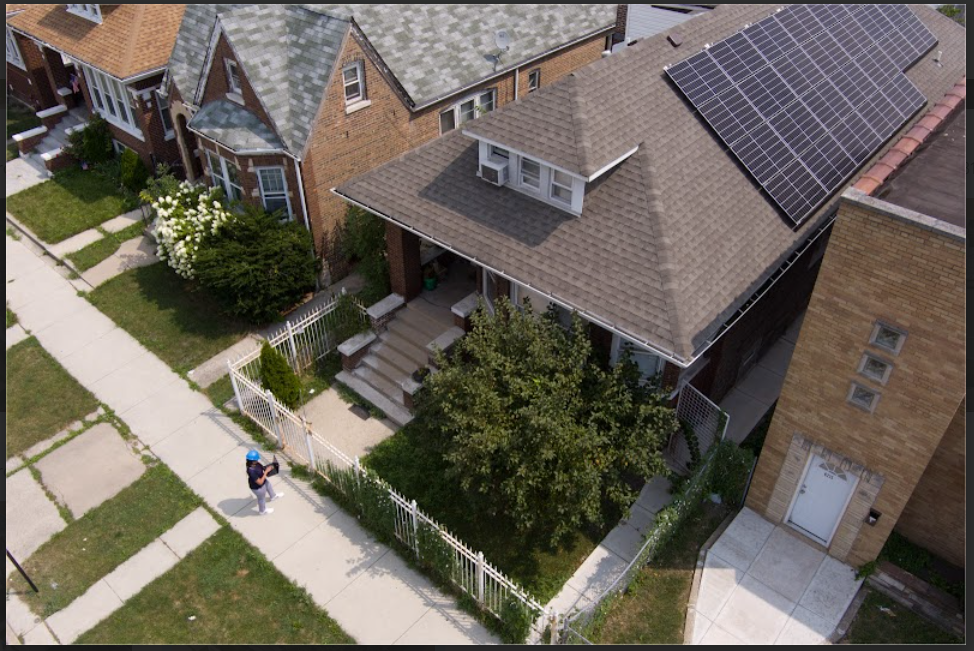Free solar reduces senior’s utilities to $0 in Chicago
- A state-funded program offers free solar panels to low-income homeowners
- Adding solar panels can increase a home’s value by 4%
- The program started with 100 homes and has grown to 1,200

Homeowner Carol McClinton speaks with Bejeray Morrison of Sunrun about solar energy on the South Side of Chicago. Courtesy of Sunrun Solar.
(NewsNation) — A solar energy program is aiming to expand green energy efforts while saving money for those who need it most.
Illinois Solar For All is helping create wealth and stability for homeowners affected by pollution and disinvestment by offering free solar panel installation to low-income homeowners.
The program has specifically found a foothole in Chicago, where winters used to worry Marie Cunningham for one big reason: “The (utility) bill always fluctuated. I never knew what it was going to be.”
The 62-year-old retiree is on a tight monthly budget. Yet for the past two years, those concerns have been a distant memory because of the Solar For All program
“I literally use my own energy,” she said. “My bill is $0 every month and it has been $0 since they put it up there.”
To qualify for the state-funded program, an Illinois resident has to make 80% of the median income of their county. Roofs have to be in good enough shape to last a 20-year contract, and electric boxes have to be up-to-date enough to process the energy from the panels.
Sunrun, a solar company installing many of the residential panels, does both the installation and the upkeep. When the contract ends, a homeowner can choose to buy or lease the system or have it taken down for free.

While most homeowners don’t see their bills drop to zero, like Cunningham, many see significant savings. Solar panels can save up to $1,500 a year in utilities and can increase a home’s value by 4%.
Paying out of pocket, though, is pricey. These solar panels cost average of $15,000 in Chicago. At first, many thought the Solar For All program was “too good to be true,” said Bejeray Morrison, program manager for Sunrun.
Previously an educator and organizer on Chicago’s South Side, she’s led a push to target neighborhoods where saving $100 a month on utilities can make a huge impact on the quality of living.
“That is a mental, physical and spiritual impactful thing,” Morrison said. “This can totally change the way someone lives by empowering them with electricity.”
The first year of the program, she convinced 100 people to try it. The next year, that number tripled. In 2022, more than 1,200 families added no-cost solar panels to their roofs.
“They get their system installed, they get their first bill, and then they call me with five or six other referrals,” she said.
Morrison added that the environmental impact was also important to residents who have historically shared their neighborhoods with some of the worst polluters in the country.

“The Southeast Side is a place where our city, our politicians have looked to put the worst (pollution) of our society,” she said. “Solar is one of those ways where we’re cleaning up our carbon footprint. … We don’t see it immediately, but in 20 years from now, we will be able to see it and feel it.”
As the popularity of the program has grown, a major barrier remains: Getting older homes solar-ready.
That’s the place where Cunningham found herself — interested in solar, yet needing repairs to her home’s electrical wiring. Further complicating things, an electric pole was leaning and wasn’t working correctly.
Sunrun’s solution is to pick up the upfront costs, paying themselves back with a mix of government rebates, incentives and subsidies. Yet it limits how many projects they can do.
“We have to disqualify three out of the four people that are interested,” Morrison said. “There’s still that gap between people who can access the program.”
For Cunningham, the company picked up the more than $1,000 in electrical costs, something the retired bus driver said she would not have been able to pay. She says she uses her monthly savings to upkeep her house and front yard.
“I’m no longer afraid to use my utilities,” she said. “My solar works for me.”









